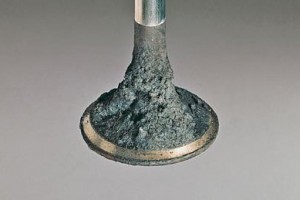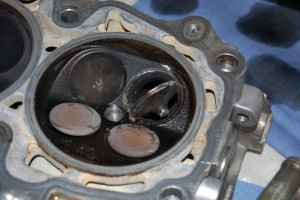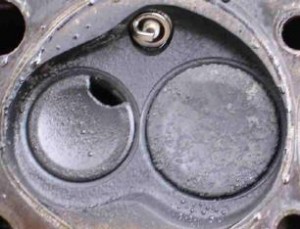In a previous post, we showed you how to read your spark plugs.
Now we’re going explain how to read your engine valves and valve-related components and translate what they’re telling you. The appearance of your intake and exhaust valves can hint at the current operating condition of your engine and foretell potential performance issues.
Here’s what your valves may be trying to tell you:
Valve Deposits
 Carbon deposits can form on your valves for a few reasons.
Carbon deposits can form on your valves for a few reasons.
Often, carbon deposits are the result of a rich fuel mixture. It can also be the result of oil passing through a worn valve guide. In this case, oil is pulled through the intake valve guide and into the combustion chamber, where it’s burned. On the exhaust side, a worn valve guide can allow oil to enter the exhaust manifold/header and some of the oil may strike the valve and form deposits. A loss of compression, poor combustion from a defective ignition, or cold-engine operation can also cause deposits to form on the exhaust valves.
If you see carbon deposits on your valves, check your valve guides for wear, make sure your ignition system is operating properly, and check for a rich condition. If too many deposits form, your valves may begin to stick and cause your engine to misfire or perform erratically.
Valve Breakage
 Valve breakage is often the result of excessive valve lash or a cocked valve spring or retainer that forces the valve to one side every time it hits. Either one of these conditions can cause additional stress on the valve and lead to metal fatigue. Replace the valve and then double check your lash and valvetrain clearances.
Valve breakage is often the result of excessive valve lash or a cocked valve spring or retainer that forces the valve to one side every time it hits. Either one of these conditions can cause additional stress on the valve and lead to metal fatigue. Replace the valve and then double check your lash and valvetrain clearances.
Excessive heat can cause the valve to stretch and fail, so check your cooling system and look for clogged coolant passages around the valve seats. Breakage can also be the byproduct of detonation or pre-ignition. In this case, you’ll need to up the octane, adjust ignition timing, and make other typical adjustments to avoid these conditions.
Bent Valves
Bent valves usually occur from contact with the pistons. This often happens because of a broken timing belt/chain or the incorrect fitment of a new belt/chain. Other possible suspects include weak or broken valve springs (remember to upgrade your springs if you upgrade your cam) and insufficient piston-to-valve clearance.
Burnt Valves
 Typically an exhaust valve problem, burnt valves are usually the result of hot combustion gasses escaping between the valve and valve seat when they don’t seal properly. Adequate sealing between the two also allows combustion heat to be conducted from the valve and into the seat, preventing the valve from overheating.
Typically an exhaust valve problem, burnt valves are usually the result of hot combustion gasses escaping between the valve and valve seat when they don’t seal properly. Adequate sealing between the two also allows combustion heat to be conducted from the valve and into the seat, preventing the valve from overheating.
Improper valve lash or a weak valve spring can prevent the valve from seating properly. The problem can be exacerbated by an inadequate or poorly operating cooling system. Clogged coolant passages around the valve seats can cause valve seat distortion and overheated/burnt valves. Detonation and pre-ignition can also cause elevated combustion temperatures and lead to burnt valves. Make all necessary adjustments to ignition timing, spark plug heat range, and fuel octane to prevent these conditions.
Another cause of burnt valves is valve seat recession. In this scenario, the valve seat is gradually worn away from the combustion chamber, altering valve clearance. If the valve no longer closes completely, the valve and seat will burn. Carbon deposits can also prevent the valve from properly seating and lead to a burnt valve condition.
Other possible causes include:
- Lean air/fuel mixture (adjust accordingly)
- Too little valvetrain clearance (check and adjust)
- Loose valve guide (tighten as needed)
- Cocked or weak valve springs (check and adjust)
Valve Face or Stem Wear
Excessive valvetrain clearance can make the valve seat with heavy impact, causing valve face wear. It also allows pounding on the valve tip, which causes the tip end to mushroom out. Check all clearances and make the necessary adjustments
If excessive valvetrain wear is not the issue, valve face wear may be the result of dirt on the valve and seat. The cure could be as simple as cleaning or changing your air filter.
Sticking Valves
This is more about valve behavior then appearance; however, a sticking valve can be telling you that there are carbon deposits on the valve stem. This is likely the result of the problems we mentioned above: gum in the fuel, overly rich air/fuel mixture, carbon from poor combustion, or even dirty oil. If your valves are sticking due to deposits, focus on these areas.
Sticking valves can also simply be the byproduct of cold-weather operation. In this case, the valves will often work free as the engine warms up. Other possible causes of sticking valves include:
- Worn valve guides (see burnt valves above)
- Warped valve stem (usually the result of overheating)
- Insufficient oil (add oil)
Proper diagnosis of your engine valves can help your engine achieve maximum performance, better fuel efficiency, and a longer life.

Good Info there are a few things I would add (some assume you are reassembling these parts) 1 check stems and guides both for dia. and wear 2 Inspect the stem to head as these are welded on oe valves 3 inspect the lock grooves on the stem and inspect the retainer the valve seat both the head and retainer4 On the actual seat apply Sharpie pen or machinists bluing to the valve and seat and spin the valve stem with your hand from the valve spring side done correctly you will have a witness mark on the seat as well as the valve This will reveal the valve seat width, the squareness of stem and seat and the depth of the seat. We use a Magnifing glass a magnifing inspection light to inspect parts you need to look for small cracks and defects Also build or buy a valve train organizer The valve train is the most stressed component on the engine its a miracle they dont fail more often Also we use a 3m loose fiber cleaning disc in a drill to clean the parts wire wheels can leave pieces imbedded in the metal also make sure you wash valves in hot water after you glass bead them the glass actually imbeds to the stem (who knew!) Jeff
Thanks very helpfull
No where have I been able to find out how long valves stick upon startup. I assume until engine warms up but what about only sticking for a few seconds or sticking warm. What about sporadically sticking? Sometimes they do, sometimes not. I can’t seem to find any info or anyone who knows the answer to this. And what about taking the valve cover off to do exploratory surgery when not sure if this is the issue? What about low mileage valve sticking. No mechanics have the answer and Google takes me to the same pages no matter the search terms. I want more info but can’t find it. Other than that, good info.
Oh and forgot, what about shifting into different gears? Maybe worse in reverse or drive? Mine’s worse in reverse, it hasn’t been diagnosed with sticking valves. They don’t know what’s wrong so this must be it. I can’t find any info on sticking valves other than sticking or idling rough. Mine is a slight misfire, shaking for 20 seconds. Shaking occurs hot and cold. I wish I could find some answers other than their guess is as good as mine. Thanks for the article.
More likely to be a blown head gasket that leaks a few drops of coolant into cylinders on shut down.
Knocks that cylinder out and takes a minute or so to clear on restart.
Cam operated valve do not stick.
Very helpful on the article about valve reading.
Hi
Excellent article and comments. One question- what happens in the case of a seized hydraulic lifter(open or closed)
Thanks